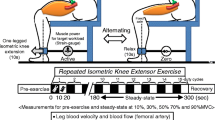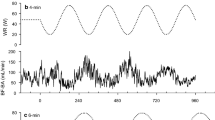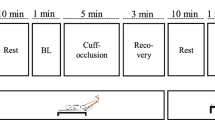Abstract
We studied the effect of exercise intensity and duration on blood flow to the non-exercising leg during one-legged dynamic knee extension. Femoral arterial blood flow (FBF) to the non-exercising leg, blood pressure (BP), and heart rate (HR) were monitored during one-legged dynamic knee extension exercise at 15, 30, and 45% maximal voluntary contraction (MVC) in seven healthy females. There was an interaction between exercise intensity and duration for FBF and FVC (P < 0.01). During the initial phase of contralateral leg exercise at all intensities, FBF and femoral vascular conductance (FVC) of non-exercising leg increased, and the increase was larger at higher intensities (P < 0.01). After initial vasodilatation, FBF and FVC decreased to baseline, which suggests the vasoconstriction. However, FBF and FVC gradually increased during exercise at 15% MVC. We conclude that transient vasodilatation at the onset of exercise is followed by gradual change to vasoconstriction in non-exercising limb during dynamic one-legged exercise and these changes are exercise intensity- and duration-dependent.



Similar content being viewed by others
References
Ahlborg G, Hagenfeldt L, Wahren J (1975) Substrate utilization by the inactive leg during one-leg or arm exercise. J Appl Physiol 39:718–723
Fisher JP, White MJ (2003) The time course and direction of lower limb vascular conductance changes during voluntary and electrically evoked isometric exercise of the contralateral calf muscle in man. J Physiol 546:315–323
Fisher JP, Sander M, MacDonald I, White MJ (2005) Decreased muscle sympathetic nerve activity does not explain increased vascular conductance during contralateral isometric exercise in humans. Exp Physiol 90:377–382
Gaffney FA, Sjogaard G, Saltin B (1990) Cardiovascular and metabolic responses to static contraction in man. Acta Physiol Scand 138:249–258
Gilligan DM, Panza JA, Kilcoyne CM, Waclawiw MA, Casino PR, Quyyumi AA (1994) Contribution of endothelium-derived nitric oxide to exercise-induced vasodilation. Circulation 90:2853–2858
Green D, Cheetham C, Mavaddat L, Watts K, Best M, Taylor R, O’Driscoll G (2002a) Effect of lower limb exercise on forearm vascular function: contribution of nitric oxide. Am J Physiol Heart Circ Physiol 283:H899–H907
Green D, Cheetham C, Reed C, Dembo L, O’Driscoll G (2002b) Assessment of brachial artery blood flow across the cardiac cycle: retrograde flows during cycle ergometry. J Appl Physiol 93:361–368
Green D, Cheetham C, Henderson C, Weerasooriya R, O’Driscoll G (2002c) Effect of cardiac pacing on forearm vascular responses and nitric oxide function. Am J Physiol Heart Circ Physiol 283:H1354–H1360
Green DJ, Bilsborough W, Naylor LH, Reed C, Wright J, O’Driscoll G, Walsh JH (2005) Comparison of forearm blood flow responses to incremental handgrip and cycle ergometer exercise: relative contribution of nitric oxide. J Physiol 562:617–628
Hohimer AR, Hales JR, Rowell LB, Smith OA (1983) Regional distribution of blood flow during mild dynamic leg exercise in the baboon. J Appl Physiol 55:1173–1177
Kagaya A, Homma S (1997) Dynamic leg accelerates blood flow in the inactive forearm. Adv Exerc Sports Physiol 3:29–34
Keller DM, Wasumund WL, Wray DW, Ogoh S, Fadel PJ, Smith ML, Raven PB (2003) Carotid baroreflex control of leg vascular conductance at rest and during exercise. J Appl Physiol 94:542–548
Kolka MA, Stephenson LA (1997) Effect of luteal phase elevation in core temperature on forearm blood flow during exercise. J Appl Physiol 82:1079–1083
Maeda S, Miyauchi T, Sakane M, Saito M, Maki S, Goto K, Matsuda M (1997) Does endothelin-1 participate in the exercise-induced changes of blood flow distribution of muscles in humans? J Appl Physiol 82:1101–1111
Osada T, Katsumura T, Hamaoka T, Inoue S, Sakamoto A, Murase N, Kajiyama J, Shimomitsu T, Iwase H (1999) Reduced blood flow in abdominal viscera measure by Doppler ultrasound during one-legged knee extension. J Appl Physiol 86:709–719
Rådegran G, Saltin B (1998) Muscle blood flow at onset of dynamic exercise in humans. Am J Physiol 274:H314–H322
Ray CA, Rea RF, Clary MP, Mark AL (1992) Muscle sympathetic nerve responses to static leg exercise. J Appl Physiol 73:1523–1529
Ray CA, Rea RF, Clary MP, Mark AL (1993) Muscle sympathetic nerve responses to dynamic one-leg exercise: effect of body posture. Am J Physiol 264:H1–H7
Saito M (1995) Differences in muscle sympathetic nerve response to isometric exercise in different muscle groups. Eur J Appl Physiol Occup Physiol 70:26–35
Saito M, Mano T, Iwase S (1990) Changes in muscle sympathetic nerve activity and calf blood flow during static handgrip exercise. Eur J Appl Physiol 60:277–281
Saito M, Sone R, Ileda M, Mano T (1997) Sympathetic outflow to the skeletal muscle in humans increases during prolonged light exercise. J Appl Physiol 82:1237–1243
Seals DR (1993) Influence of force on muscle and skin sympathetic nerve activity during sustained isometric contractions in humans. J Physiol 462:147–159
Sinoway L, Prophet S, Gorman I, Mosher T, Shenberger J, Dolecki M, Briggs R, Zelis R (1989) Muscle acidosis during static exercise is associated with calf vasoconstriction. J Appl Physiol 66:429–436
Tanaka H, Shimizu S, Ohmori F, Muraoka Y, Kumagai M, Yoshizawa M, Kagaya A (2006) Increases in blood flow and shear stress to nonworking limbs during incremental exercise. Med Sci Sports Exerc 38:81–85
Taylor JA, Joyner MJ, Chase PB, Seals DR (1989) Differential control of forearm and calf vascular resistance during one-leg exercise. J Appl Physiol 67:1791–1800
Acknowledgments
This research was supported by “Academic Frontier Project,” 2004, at Japan Women’s College of Physical Education (project leader, A. Kagaya).
Author information
Authors and Affiliations
Corresponding author
Rights and permissions
About this article
Cite this article
Yoshizawa, M., Shimizu-Okuyama, S. & Kagaya, A. Transient increase in femoral arterial blood flow to the contralateral non-exercising limb during one-legged exercise. Eur J Appl Physiol 103, 509–514 (2008). https://doi.org/10.1007/s00421-008-0740-8
Accepted:
Published:
Issue Date:
DOI: https://doi.org/10.1007/s00421-008-0740-8




